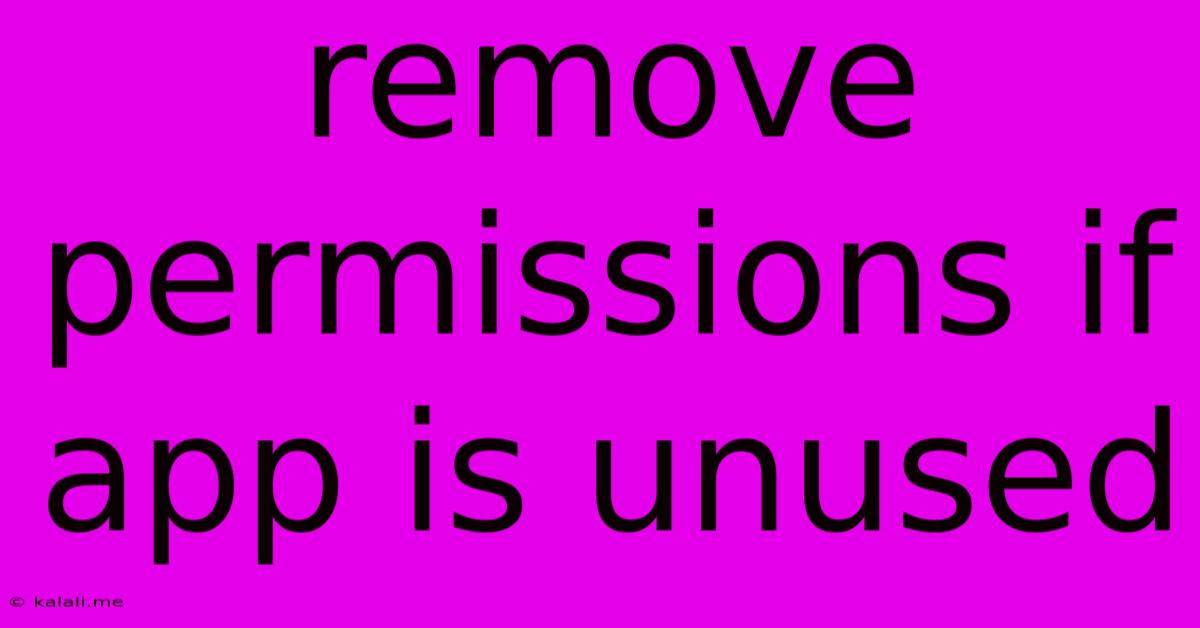Remove Permissions If App Is Unused
Kalali
Jun 06, 2025 · 3 min read

Table of Contents
Remove Permissions if App is Unused: Reclaim Your Privacy and Optimize Your Phone
Are you tired of apps hogging unnecessary permissions on your smartphone? Do you feel a little uneasy about the level of access some apps have to your personal data, especially those you rarely or never use? You're not alone. This article will guide you through the process of reviewing and revoking permissions for unused applications, boosting your phone's performance and enhancing your privacy in the process. By taking control of app permissions, you can regain a sense of security and optimize your device's efficiency.
Understanding App Permissions
Before diving into the removal process, it's crucial to understand what app permissions are and why they matter. When you download an app, it often requests access to various aspects of your phone, such as your contacts, location, camera, microphone, and storage. These permissions allow the app to function as intended, but excessive or unnecessary permissions can pose a privacy risk and drain your battery. Many apps request broader permissions than actually needed for their core functionality.
Identifying Unused Apps
The first step is to identify the apps you no longer use. Take a look at your app list and honestly assess which ones you haven't opened in weeks or months. Consider the last time you actively used each application; if it's been a significant period, it's a prime candidate for permission review. You might be surprised by how many apps linger on your phone, silently consuming resources and potentially accessing your data without your knowledge. This process is essential for prioritizing which apps need permission reconsideration.
Removing Unnecessary Permissions: A Step-by-Step Guide
The methods for removing app permissions vary slightly depending on your operating system (Android or iOS). However, the general principles remain the same.
Android:
- Open Settings: Locate and open the "Settings" app on your Android device.
- Navigate to Apps: Find the "Apps" or "Applications" section within the settings menu. This might be labeled differently depending on your phone's manufacturer and Android version.
- Select the App: Choose the app you want to review and manage permissions for.
- Access Permissions: Look for the "Permissions" option within the app's settings.
- Review and Revoke: Carefully review the permissions granted to the app. Uncheck or revoke any permissions that seem unnecessary or excessive. Consider the app's core function and if the permission is truly essential for it to operate.
iOS:
- Open Settings: Tap the "Settings" app icon on your iPhone or iPad.
- Select Privacy & Security: Find and tap "Privacy & Security."
- Choose App Permissions: This section lists various permissions (Location Services, Camera, Photos, etc.).
- Manage App Access: Tap on each permission category to see which apps have access. You can toggle permissions on or off for individual apps.
Important Considerations:
- App Functionality: Be aware that revoking certain permissions might limit the app's functionality. Before revoking a permission, consider whether it's crucial for the app's core features.
- Re-enabling Permissions: You can always re-enable permissions later if you find that the app requires them to function properly.
- Regular Review: Make it a habit to review your app permissions periodically. As apps update, their permission requests might change.
Boosting Privacy and Performance
By removing unnecessary app permissions, you significantly enhance your privacy and optimize your device's performance. Fewer permissions mean less data collection, reduced battery drain, and improved overall system responsiveness. This proactive approach to managing your digital footprint is essential in today's increasingly connected world. Regularly auditing your apps and their permissions is a crucial step in maintaining both privacy and a smoothly functioning device. Remember that taking control of your app permissions is a simple yet powerful way to protect your data and enhance your mobile experience.
Latest Posts
Latest Posts
-
How Do I Wire A 3 Way Dimmer Switch
Jun 06, 2025
-
How To Recycle Plastics At Home
Jun 06, 2025
-
How To Get Rid Of Dirt Dauber Nest
Jun 06, 2025
-
What Happens If You Dont Grease Brake Pads
Jun 06, 2025
-
Set You Up To Get In Trouble
Jun 06, 2025
Related Post
Thank you for visiting our website which covers about Remove Permissions If App Is Unused . We hope the information provided has been useful to you. Feel free to contact us if you have any questions or need further assistance. See you next time and don't miss to bookmark.